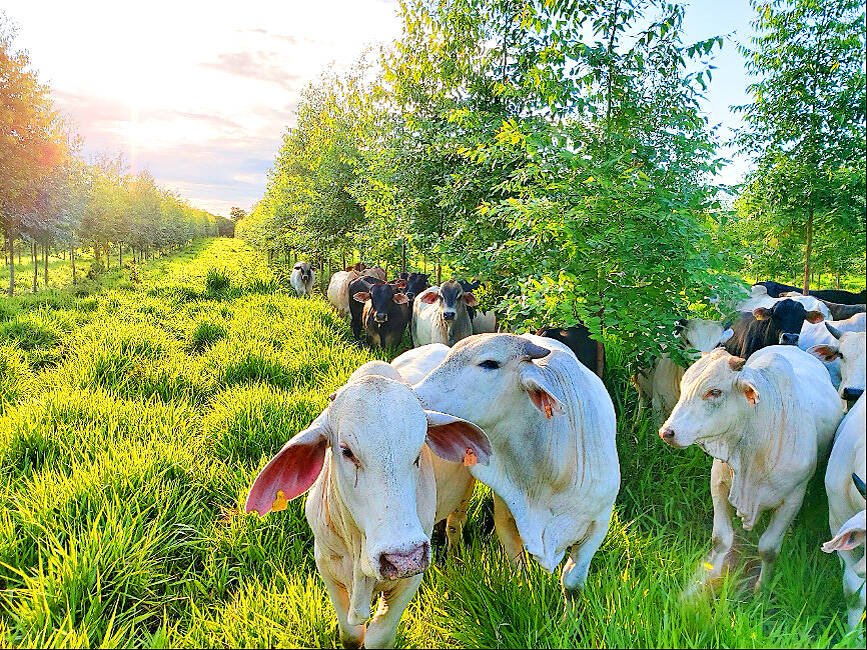The Taiwan Carbon Solution Exchange (TCX) has listed its first green carbon project, and expects it to generate carbon credits for 10,000 tonnes of carbon.
The newly listed project is an afforestation initiative in eastern Paraguay, a diplomatic ally of Taiwan, and carbon credits for the project are available for purchase, the TCX said in a statement on Monday.
However, the TCX provided no other details regarding the nature of the project or how far along it is.

Photo courtesy of the Taiwan Carbon Solution Exchange
The exchange said it was crucial for Paraguay to receive support to develop and protect its forests, as well as to promote carbon reduction initiatives, because its forest cultivation regulations are underdeveloped.
A significant share of Paraguay’s land is also used for cattle and soy farming, the TCX said.
Beef has the biggest carbon footprint of any food, Greenpeace Taiwan has said.
Soy cultivation contributes to carbon emissions and deforestation in many South American countries, including Paraguay, the World Wildlife Fund says.
The green carbon project is the second nature-based solution to comply with international carbon neutrality standards, such as ISO 14068-1, and to be listed on the exchange, the TCX said.
The first nature-based solution — a blue carbon project involving mangroves in Myanmar — was launched in June, it said.
Nature-based solutions “are actions to protect, sustainably manage and restore natural and modified ecosystems in ways that address societal challenges effectively and adaptively, to provide both human well-being and biodiversity benefits,” the International Union for Conservation of Nature says.
Green carbon and blue carbon projects are different types of nature-based solutions. Green carbon refers to carbon stored by terrestrial ecosystems, mainly land-based vegetation such as forests, while blue carbon refers to carbon stored in marine and coastal ecosystems.
The two nature-based solution projects were established in accordance with Ministry of Environment regulations and TCX’s operational procedures, and would be analyzed by researchers at Taiwanese universities, the exchange said.
The TCX was set up in August last year and began trading carbon credits in December. It is Taiwan’s only certified exchange for trading on international voluntary carbon markets.
Separately, the Ministry of Environment (MOENV) said yesterday that it expects sales of domestic carbon credits on the TCX to begin by late September or early October.
The MOENV gave the timeline following the public release of regulations on the trade and transfer of domestic carbon credits from voluntary emission reduction projects set to be introduced on Aug. 15.
MOENV Climate Change Administration Deputy Director-General Huang Wei-ming (黃偉鳴) said the estimate was based on the time needed to complete administrative procedures.
“We can only commission the TCX to be the trading platform with the regulations in place, and time is needed for our system on emission reduction to coordinate with the TCX’s trading system,” he added.
Under the regulations, the TCX will be the only certified platform for the trade and auction of domestic carbon credits.
According to the MOENV, the regulations, including the ban on private brokerage, consignment or trade of domestic carbon credits, guarantee trade security and ensure transparency.
Information about the credits, such as project type and duration of the monitor, will be coded to ensure the effectiveness of the credits for trade, auction, and use (for carbon offset) and to prevent “greenwashing,” the ministry said.
Only sellers who have had their emission reduction projects overseen by the government will be permitted to auction or sell domestic carbon credits, it said.
The buyers will be limited to those allowed to acquire carbon credits to offset their emissions under Article 26 of the Climate Change Response Act (氣候變遷因應法), including those who emit more than 25,000 metric tons of carbon dioxide equivalent per year and are scheduled to be charged with carbon fees later this year.
In addition, buyers will be banned from reselling traded or auctioned domestic carbon credits on the TCX to “ensure market stability,” the ministry said.

FOUR DESIGNATED AREAS: Notices were issued for live-fire exercises in waters south and northwest of Penghu, northeast of Keelung and west of Kaohsiung, they said The military is planning three major annual exercises across the army, navy and air force this month, with the navy’s “Hai Chiang” (海強, “Sea Strong”) drills running from today through Friday, the Ministry of National Defense said yesterday. The Hai Chiang exercise, which is to take place in waters surrounding Taiwan, would feature P-3C Orion maritime patrol aircraft and S-70C anti-submarine helicopters, the ministry said, adding that the drills aim to bolster the nation’s offshore defensive capabilities. China has intensified military and psychological pressure against Taiwan, repeatedly sending warplanes and vessels into areas near the nation’s air defense identification zone and across

FORCED LABOR: A US court listed three Taiwanese and nine firms based in Taiwan in its indictment, with eight of the companies registered at the same address Nine companies registered in Taiwan, as well as three Taiwanese, on Tuesday were named by the US Department of the Treasury’s Office of Foreign Assets Control (OFAC) as Specially Designated Nationals (SDNs) as a result of a US federal court indictment. The indictment unsealed at the federal court in Brooklyn, New York, said that Chen Zhi (陳志), a dual Cambodian-British national, is being indicted for fraud conspiracy, money laundering and overseeing Prince Holding Group’s forced-labor scam camps in Cambodia. At its peak, the company allegedly made US$30 million per day, court documents showed. The US government has seized Chen’s noncustodial wallet, which contains

SUPPLY CHAIN: Taiwan’s advantages in the drone industry include rapid production capacity that is independent of Chinese-made parts, the economic ministry said The Executive Yuan yesterday approved plans to invest NT$44.2 billion (US$1.44 billion) into domestic production of uncrewed aerial vehicles over the next six years, bringing Taiwan’s output value to more than NT$40 billion by 2030 and making the nation Asia’s democratic hub for the drone supply chain. The proposed budget has NT$33.8 billion in new allocations and NT$10.43 billion in existing funds, the Ministry of Economic Affairs said. Under the new development program, the public sector would purchase nearly 100,000 drones, of which 50,898 would be for civil and government use, while 48,750 would be for national defense, it said. The Ministry of

SENATE RECOMMENDATION: The National Defense Authorization Act encourages the US secretary of defense to invite Taiwan’s navy to participate in the exercises in Hawaii The US Senate on Thursday last week passed the National Defense Authorization Act (NDAA) for Fiscal Year 2026, which strongly encourages the US secretary of defense to invite Taiwan’s naval forces to participate in the Rim of the Pacific (RIMPAC) exercise, as well as allocating military aid of US$1 billion for Taiwan. The bill, which authorizes appropriations for the military activities of the US Department of Defense, military construction and other purposes, passed with 77 votes in support and 20 against. While the NDAA authorizes about US$925 billion of defense spending, the Central News Agency yesterday reported that an aide of US